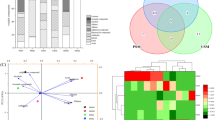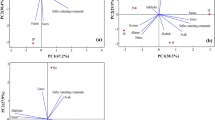Abstract
Soy sauce contains a variety of volatiles that are highly valuable to its quality with regard to sensory characteristics. This paper describes the analysis of volatile compounds influencing the flavor quality of Chinese-type soy sauces. Gas chromatography–mass spectrometry (GC–MS) combined with headspace-solid phase microextraction and electronic nose (E-nose) were applied for identifying the volatile flavor compounds as well as determining their volatile profiles of 12 soy sauces manufactured by different fermentation process. Forty one key volatile components of these 12 soy sauce products, a pure soy sauce and an acid-hydrolyzed vegetable protein sample, were compared in semi-quantitative form, and their volatile flavor profiles were analyzed by E-nose. The substantially similar results between hierarchical cluster analysis based on GC–MS data and E-nose analysis suggested that both techniques may be useful in evaluating the flavor quality of soy sauces and differentiating soy sauce products. The study also showed that there were less volatile flavor compounds in soy sauces produced through low-salt solid-state fermentation process, a traditional manufacturing technology and a widely adopted technology in Chinese soy sauce industries. In addition, the investigation suggested that the flavor quality of soy sauce varied widely in Chinese domestic market, and that the present Chinese national standards of soy sauce should be further perfected by the addition of flavor grades of soy sauce in the physical and chemical index. Meanwhile, this research provided valuable information to manufacturers and government regulators, which have practical significance to improve quality of soy sauces.



Similar content being viewed by others
References
Aishima T (2006) Comparing predictability of GC–MS and e-nose for aroma attributes in soy sauce using PLS regression analysis. Flavour Sci Recent Adv Trends 43:525–528
Baek HH, Kim HJ (2004) Solid phase microextraction-gas chromatography-olfactometry of soy sauce based on sample dilution analysis. Food Sci Biotechnol 13:90–95
Bao QA (2011) The aroma of soy sauce. In: Bao QA (ed) Science and brewing technology of soy sauce. China Light Industry Press, Beijing, pp 44–73
Chinese national food safety standards: Fermented soy sauce. GB 18186-2000
Chinese national food safety standards: Standards for food additives. GB 2760-2010
Feng J, Zhan XB, Zhang XB, Wang D, Zhang LM, Lin CC (2013a) New model for flavour quality evaluation of soy sauce. Czech J Food Sci 31:292–305
Feng YZ, Cui C, Zhao HF, Gao XL, Zhao MM, Sun WZ (2013b) Effect of koji fermentation on generation of volatile compounds in soy sauce production. Int J Food Sci Technol 48:609–619
Feng YZ, Cai Y, Sun-Waterhouse DX, Cui C, Su GW, Lin LZ, Zhao MM (2015) Approaches of aroma extraction dilution analysis (AEDA) for headspace solid phase microextraction and gas chromatography–olfactometry (HSSPME–GC–O): altering sample amount, diluting the sample or adjusting split ratio? Food Chem 187:44–52
Gao XL, Zhao MM, Cui C, Cao MK, Li D (2009) Isolation and identification of volatile flavor compounds in high-salt dilute-state soy sauce. J South China Univ Technol Nat Sci Ed 37:117–122
Gao XL, Cui C, Zhao HF, Zhao M, Yang ML, Ren JY (2010) Changes in volatile aroma compounds of traditional Chinese-type soy sauce during moromi fermentation and heat treatment. Food Sci Biotechnol 19:889–898
Harrison TJ, Dake GR (2005) An expeditious, high-yielding construction of the food aroma compounds 6-acetyl-1,2,3,4-tetrahydropyridine and 2-acetyl-1-pyrroline. J Org Chem 70:10872–10874
Hayase F, Takahagi Y, Watanabe H (2013) Analysis of cooked flavor and odorants contributing to the Koku taste of seasoning soy sauce. J Jpn Soc Food Sci Technol Nippon Shokuhin Kagaku Kaishi 60:59–71
Kaneko S, Kumazawa K, Nishimura O (2012) Comparison of key aroma compounds in five different types of Japanese soy sauces by aroma extract dilution analysis (AEDA). J Agric Food Chem 60:3831–3836
Kaneko S, Kumazawa K, Nishimura O (2013) Studies on the key aroma compounds in raw (uUnheated) and heated Japanese soy sauce. J Agric Food Chem 61:3396–3402
Lee SM, Seo BC, Kim YS (2006) Volatile compounds in fermented and acid-hydrolyzed soy sauces. J Food Sci 71:146–156
Lertsiri S, Wanakhachornkrai P, Assavanig A, Chaiseri S, Suwonsichon T (2010) Volatile flavor compounds and flavor profiles of Thai soy sauce. Chem Text Flavor Soy 1059:375–387
Meng Q, Kakuta T, Sugawara E (2012) Quantification and odor contribution of volatile thiols in Japanese soy sauce. Food Sci Technol Res 1:2429–2436
Nunomura N, Sasaki M, Yokosuka T (1984) (Soy sauce) flavor components: neutral fraction. Agric Biol Chem 48:753–1762
Sun SY, Jiang WG, Zhao YP (2010) Profile of volatile compounds in 12 Chinese soy sauces produced by a high-salt-diluted state fermentation. J Inst Brew 116:316–328
Van den Dool H, Kratz PD (1963) A generalization of the retention index system including linear temperature programmed gas-liquid partition chromatography. J Chromatogr A 11:463–471
Vander SC, Rahardjo YSP, Smit BA (2002) Concomitant extracellular accumulation of alpha-keto acids and higher alcohols by Zygosaccharomyces rouxii. J Biosci Bioeng 93:117–124
Wanakhachornkrai P, Lertsiri S (2003) Comparison of determination method for volatile compounds in Thai soy sauce. Food Chem 83:619–629
Wongpornchai S, Sriseadka T, Choonvisase S (2003) J Agric Food Chem 51:457–462
Zhang SH, Liu Y (eds) (2000) Condiment production technology. South China University of Technology Press, Guangzhou, p 10
Zhang YF, Tao WY (2009) Flavor and taste compounds analysis in Chinese solid fermented soy sauce. Afr J Biotechnol 8:673–681
Acknowledgements
This work is supported by the National Natural Science Foundation of China (Grant No. 31171738).
Author information
Authors and Affiliations
Corresponding author
Rights and permissions
About this article
Cite this article
Gao, L., Liu, T., An, X. et al. Analysis of volatile flavor compounds influencing Chinese-type soy sauces using GC–MS combined with HS-SPME and discrimination with electronic nose. J Food Sci Technol 54, 130–143 (2017). https://doi.org/10.1007/s13197-016-2444-0
Revised:
Accepted:
Published:
Issue Date:
DOI: https://doi.org/10.1007/s13197-016-2444-0




